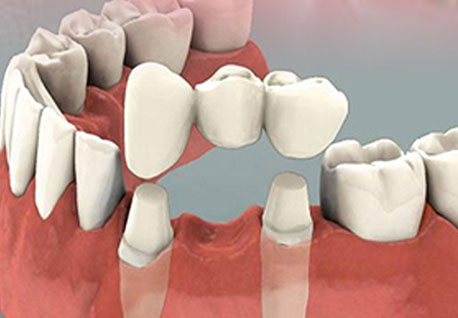Crowns & Bridges
Crowns are used to cover teeth that are weakened by decay, severely damaged, chipped, or discolored. They are also usually required after Root Canal Therapy. The tooth is shaped to support the crown. The crowns can be metal-containing or metal-free. Zirconia crowns, popularly known as All-Ceramic or Metal-free crowns are sued with Computer Aided Technology for the highest level of precision and accuracy.

CROWNS
When a tooth is heavily decayed it is more likely to fracture and lose considerable tooth substance. The greater risk is that a fracture line may go below the margin of the gum which makes restoration more difficult or near impossible.
Crowns may be made from several different materials, gold and porcelain being the most common types. Gold is usually used on the back teeth, as it has several advantages over porcelain teeth. – Gold is strong in thin section and less tooth needs to be drilled away before taking the impression and fitting the crown. – The lab technician finds it easier to use gold as it shrinks less when cast and is easier to polish. Crowns of porcelain shrink when cast and the technician has to estimate this when making the crown. Porcelain is usually always used for the front teeth but may be used for the back teeth. This material can be made to appear very natural though several factors affect this and are outlined below; Some porcelain crowns have metal inside which gives strength and support to the porcelain. This acts as a barrier for light and gives the crown a dull color. On posterior teeth, this won’t be noticed but in the front of the mouth, it can occasionally be a problem as the tooth looks duller than the natural teeth.
BRIDGE
A bridge allows the dentist to replace lost teeth without the use of a denture or dental implant. Basically a false tooth is held in place by being attached to a tooth next door. The disadvantage is that the teeth next to space have to be prepared in a similar way to a crown in order to accept the bridge.
If these teeth already have crowns or big restorations then this is not a problem, the major concern, however, is when these teeth have small or no restorations (fillings). One compromise is the ‘acid etched bridge’, with this type a fine ledge is placed on the back of the adjacent teeth One disadvantage of a bridge is that the patient should wait three months before placement as the ‘gum’ shrinks’ after a tooth is extracted. If the bridge was fitted early a gap would appear underneath the pontic (the false tooth). At the back of the mouth, this may not be a problem, at the front of the mouth however this may appear as a black line along with the gum.
PATIENT TESTIMONIALS

Dr. Manish Raj who showed lots of concern and did a wonderful root canal therapy and saved my tooth."The meticulous and patient approach and that kind of human touch are worth mentioning. He acts with confidence and hence is always successful."
Dr. Varsha Agarwal
Consultant Pathologist KNMH,Prayagraj
Before coming to SMILE DESIGNER DENTAL HOSPITAL, I was always apprehensive to visit a dentist, and the result was that I had a bad caries molar tooth. There seemed no option except the loss of tooth. It was then Dr. Manish Raj who showed lots of concern and did a wonderful root canal therapy and saved my tooth." The meticulous and patient approach and that kind of human touch are worth mentioning. He acts with confidence and hence is always successful."
Chaya.P.Mishra
Consultant Nutritionist, Prayagraj
when I visited Dr.Manish Raj but he made everything appear extremely easy and comforted me. Thank you 'Smile designers'Everyone was so friendly and helpful. The office was very professional, and they really took the time to make me feel comfortable and welcome. Their commitment to making sure I was 100% satisfied.."
Nuzra Mansoor Khan
Lucknow
